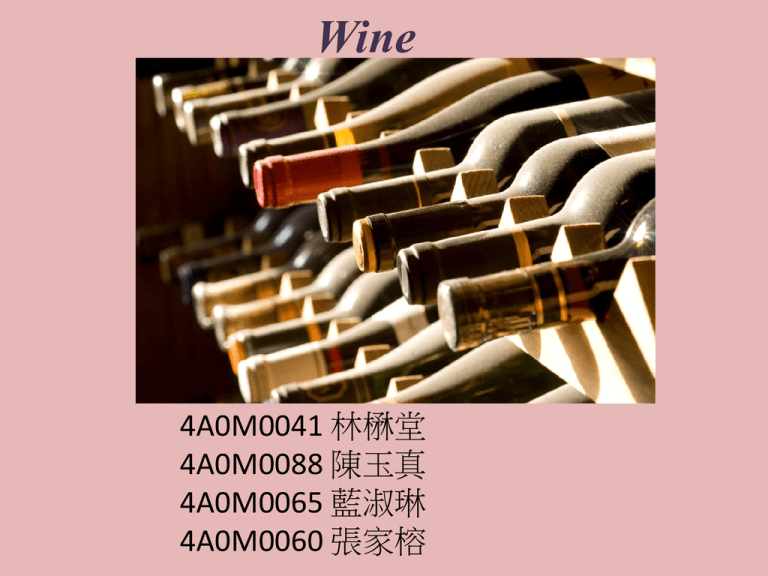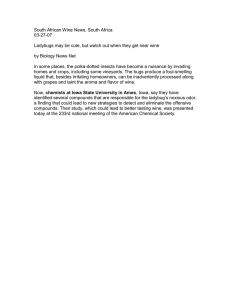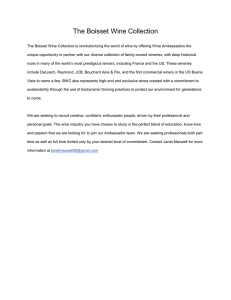Wine 4A0M0041 林楙堂 4A0M0088 陳玉真 4A0M0065 藍淑琳
advertisement

Wine 4A0M0041 林楙堂 4A0M0088 陳玉真 4A0M0065 藍淑琳 4A0M0060 張家榕 • Wine is an alcoholic beverage made from fermented grapes or other fruits. The natural chemical balance of grapes lets them ferment without the addition of sugars, acids, enzymes, water, or other nutrients. Yeast consumes the sugars in the grapes and converts them into alcohol. Different varieties of grapes and strains of yeasts produce different types of wine. The well-known variations result from the very complex interactions between the biochemical development of the fruit, reactions involved in fermentation, and human intervention in the overall process. The final product may contain tens of thousands of chemical compounds in amounts varying from a few percent to a few parts per billion. How is wine made? • Yeast is the magical ingredient that turns grape juice into wine. Interestingly enough, there is actually wild yeast spores in the air and all that is really needed to make wine is an open container of grape juice and time. The result however, would probably not be the most palatable of beverages. Wine color? • You probably know that there are green grapes and black grapes and different grapes are used to make different wines. But how too make the wine become different color on it? The way a wine gets its color is by letting the skins soak in the juice during fermentation. You can actually make white wine from black grapes by not letting the skins stay in contact with the juice. Champagne is one of the most famous examples. What gives each wine the flavor? • Even though there are very few ingredients, there are many things which influence the taste of wine. First of all, there are many varieties of grapes. Each grape variety will produce different flavors, aromas, and even textures. • In addition, the soil and climate where the grapes are grown drastically affect these variables. • Not only that, but the wine maker can control various things by the technique, temperature and yeast used during fermentation. Other variables such as fermenting or storing in oak barrels will also affect the taste. Producing regions • Now wine have produced by many country 1.Africa (Algeria,Cape Verde ,Morocco SouthAfrica,unisia) 2.Americas(Argentina,Bolivia,Brazil,Canada,Chile, Mexico,Peru,United States,Uruguay,Venezuela) 3.Europe(Austria,Armenia,Azerbaijan,Belgium,Bulga ria,Croatia,Cyprus,Czech Republic,Denmark,France,Georgia,Germany,Gree ce,Hungary,Ireland,Italy,Luxembourg,Macedonia, Moldova,Montenegro,Netherlands,Poland,Portug al,Romania,Russia,Serbia,Slovakia,Slovenia,Spain, Sweden,Switzerland,Turkey,Ukraine,United Kingdom) 4. Asia(China,India,Indonesia,Iran,Israel,Japan, Kazakhstan,Republic of Korea,Lebanon, Burma, Palestinian territories,Syria,Vietnam) 5. Oceania (Australia,New Zealand) Storage • Storage is an important consideration for wine that is being kept for long-term aging. While most wine is consumed within 24 hours of purchase, fine wines are often set aside for long-term storage. Wine is one of the few commodities that can improve with age but it can also rapidly deteriorate if kept in inadequate conditions. The three factors that have the most direct impact on a wine's condition are light, humidity and temperature.


